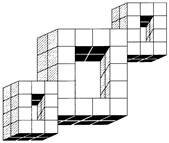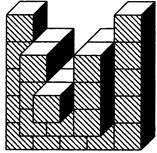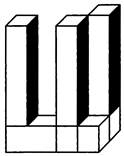Worksheet: Cubes | Know Your Aptitude Class 6 To 8 - Class 8 PDF Download
Multiple Choice Questions (MCQs)
Q1: Directions: A cube is coloured red on all of its faces. It is then cut into 64 smaller cubes of equal size. The smaller cubes so obtained are now separated.
How many smaller cubes have two surfaces painted with red colour?
(a) 24
(b) 8
(c) 12
(d) 20
Q2: Directions: A cube is coloured red on all of its faces. It is then cut into 64 smaller cubes of equal size. The smaller cubes so obtained are now separated.
How many smaller cubes have no face coloured?
(a) 24
(b) 16
(c) 8
(d) 10
Q3: Directions: Observe the figure of a plane view of a cube and answer the given questions following it.  Which two faces will be opposite to each other?
Which two faces will be opposite to each other?
(a) P and R
(b) Q and S
(c) P and U
(d) Q and U
Q4: Directions: Observe the figure of a plane view of a cube and answer the given questions following it.  Which face will be at top if face "T" will be at the bottom?
Which face will be at top if face "T" will be at the bottom?
(a) Q
(b) R
(c) S
(d) U
Q5: Directions: Observe the figure of a plane view of a cube and answer the given questions following it.  Which face will be opposite to face "T" after folding a cube?
Which face will be opposite to face "T" after folding a cube?
(a) P
(b) Q
(c) R
(d) S
Q6: What is the maximum number of identical pieces a cube can be cut into by 7 cuts?
(a) 27
(b) 36
(c) 38
(d) 49
Q7: What is the least number of cuts required to cut a cube into 24 identical pieces?
(a) 5
(b) 6
(c) 7
(d) 8
Q8: Count the number of cubes in the given figure.
(a) 64
(b) 66
(c) 68
(d) 70
Q9: Count the number of cubes in the given figure.
(a) 25
(b) 30
(c) 32
(d) 34
Q10: Count the number of blocks in the given figure.
(a) 6
(b) 7
(c) 8
(d) 9
You can access the solutions to this worksheet here.
|
5 videos|60 docs|13 tests
|
FAQs on Worksheet: Cubes - Know Your Aptitude Class 6 To 8 - Class 8
| 1. What are the basic properties of cubes that one should understand for solving related problems? |  |
| 2. How do you calculate the volume and surface area of a cube? |  |
| 3. What are some common mistakes to avoid when working with cubes in geometry? |  |
| 4. How can cubes be applied in real-world situations? |  |
| 5. Are there any advanced topics related to cubes that can be explored further? |  |




















